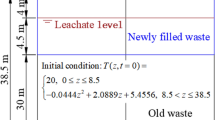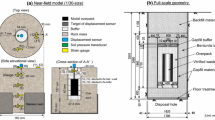Abstract
Safe disposal of high-level waste is a challenging problem facing the scientific, technological, and engineering communities. The actual high-level waste disposal is closely related to the number of waste canisters in a single borehole. The influence of the number of waste canisters in a single borehole on the near-field temperature, stress, and displacement of the repository is directly related to the safety and cost of waste disposal. In this paper, based on the conceptual model of the high-level waste repository, the influence of the number of waste canisters in a single vertical borehole on the near-field temperature, stress, and displacement of the high-level waste repository was calculated and analyzed by using the 3DEC program. The results show that as the number of waste canisters in a single borehole increases, its heat release capacity is enhanced, and the temperature in the same area near the repository increases gradually; the temperature gradient increases gradually. The more waste canisters in a single borehole, the higher the temperature of the observation point near the same location of the repository (about 30°C), the temperature difference is getting larger and larger, and the average increase of temperature difference at observation point is about 8.1°C. The change of normal stress at the observation point is obvious when the waste canister releases heat for about 0–1 year; after that, the compressive stress decreased slightly, and then the stress and time curve was basically horizontal; the stress difference is getting larger and larger; the average increase of stress difference is about 0.0545MPa.The general trend of observation point displacement is that when the waste canister releases heat for about 0–1 year, displacement increases greatly, and then displacement increases less and presents a linear distribution trend; the displacement difference is getting larger and larger; the average increase of displacement difference is about 0.00034m. The thermal superposition effect of waste canisters added in a single borehole in engineering design cannot be ignored, and it showed that attention should be paid to the number of waste canisters in the disposal pit.








Similar content being viewed by others
References
Chen L, Qiao L, Cui M, Li QW (2017) Implementation of the strain hardening model into buffer material in high level waste repository. Geosci J 21(2):277–289. https://doi.org/10.1007/s12303-016-0046-5
Chevallier L, Verwoerd WJ (1990) Influence of temperature on the distribution of stress and displacement in a volcano: a numerical approach. Bull Volcanol 52(6):413–425. https://doi.org/10.1007/BF00268923
Dutt A, Saini MS, Singh TN, Verma AK, Bajpai RK (2012) Analysis of thermo-hydrologic -mechanical impact of repository for high-level radioactive waste in clay host formation: an Indian reference disposal system. Environ Earth Sci 66:2327–2341. https://doi.org/10.1007/s12665-011-1455-4
Jia ML, Wan L, Li HH, Zhao SW, Liu W, Yang ZT, Sun QH (2015) Study on package numbers in single vertical borehole in high level waste repository. Atomic Energy Science and Technology 49(5):787–794. https://doi.org/10.7538/yzk.2015.49.05.0787
Koyama T, Chijimatsu M, Shimizu H, Nakama S (2013) Numerical modeling for the coupled thermo-mechanical processes and spalling phenomena in Äspö Pillar Stability Experiment(APSE). J Rock Mech Geotech Eng 5:58–72. https://doi.org/10.1016/j.jrmge.2013.01.001
Li ZG, Huai XL, Wang L, Tao YJ (2009) Influence of longitudinal rise of coolant temperature on the thermal strain in a cylindrical laser rod. Opt Lett 34(2):187–189. https://doi.org/10.1364/OL.34.000187
Liu WG, Wang J, Zhou HW, Yang CH, Jiang PF (2009a) Coupled thermo-mechanical analysis of granite for high-level radioactive waste repository. Chin J Rock Mech Eng 28(S1):2875–2883
Liu YM, Wang J, Cai MF, Wang SR, Ke D (2009b) Study on disposal pit space for high-level radioactive waste in thermal-mechanical coupling condition. Uranium Geology 25(6):373–379. https://doi.org/10.1002/9780470611807.ch2
Liu C, Zhang YL, Zheng G, Sun PP (2015) Modified method for calculating temperature stress and displacement in horizontal strut of foundation pits. Chin J Geotech Eng 37(S1):61–64. https://doi.org/10.11779/CJGE2015S1013
Liu J, Li S, Liu QY, Liu ZJ, Li LC, Xiao GH (2017) Temperature field analysis on the highly-deviated wellbore in backwashing condition. J Pet Sci Eng 161:515–529. https://doi.org/10.1016/j.petrol.2017.12.018
Lv T, Yang QY, Wang XH, An GM, Li TJ, Zhang W, (2012) The conceptual design of underground general layout of geological repository of high level radioactive waste in China∥Proceedings of the 4th Symposium on Underground Waste Disposal. Beijing
Maheshwar S, Verma AK, Singh TN, Bajpal RK (2015) Study of thermo-hydro-mechanical processes at a potential site of an Indian nuclear waste repository. J Earth Syst Sci 124(8):1693–1708
Millard A, Mokni N, Barnichon JD, Thatcher K, Bond A, Fraser-Harris A, Mc Dermott C, Blaheta R, Michalec Z, Hasal M, Nguyen TS, Nasir O, Yi H, Kolditz O (2017) Comparative modelling approaches of hydro-mechanical processes in sealing experiments at the Tournemire URL. Environ Earth Sci 76(2):78. https://doi.org/10.1007/s12665-016-6324-8
Qin AF, Wang HT, Zhao XL (2013) Influence of heat source on near field behavior of nuclear waste repository. Journal of Shanghai University (Natural Science) 19(5):520–525. https://doi.org/10.3969/j.issn.1007-2861.2013.05.015
Sánchez M, Gens A, Guimarães L (2012) Thermal–hydraulic–mechanical (THM) behaviour of a large-scale in situ heating experiment during cooling and dismantling. Can Geotech J 49(10):1169–1195. https://doi.org/10.1139/t2012-076
Thomas HR, Vardon PJ, Cleall PJ (2014) Three-dimensional behaviour of a prototype radioactive waste repository in fractured granitic rock. Can Geotech J 51(3):19–259. https://doi.org/10.1139/cgj-2013-0094
Tsang CF, Barnichon JD, Birkholzer J, Li XL, Liu HH, Sillene X (2012) Coupled thermo-hydro-mechanical processes in the near field of a high-level radioactive waste repository in clay formations. Int J Rock Mech Min Sci 49:31–44. https://doi.org/10.1016/j.ijrmms.2011.09.015
Wang S, Zhang P, Nie Z, Wu D, Liu X (2015) Numerical modeling of the influence of temperature and driving current on “smile” in high power diode laser arrays. 2015 16th International Conference on Electronic Packaging Technology (ICEPT) IEEE. 10.1109/ICEPT.2015.7236552
Wang J, Ling H, Chen WM (2017) Study on the safety functions of repository for geological disposal of high level radioactive waste. China Nuclear Power 10(2):270–278. https://doi.org/10.12058/zghd.2017.02.270
Yan CL, Deng JG, Yu BH, Li WL, Li Y (2013) Borehole stability in high-temperature formations. Rock Mech Rock Eng 47(6):2199–2209. https://doi.org/10.1007/s00603-013-0496-2
Zhang CL (2018) Thermo-hydro-mechanical behavior of clay rock for deep geological disposal of high-level radioactive waste, Journal of Rock Mechanics and Geotechnical Engineering. 10(5):192–208. https://doi.org/10.1016/j.jrmge.2018.03.006
Zhang YH, Li Q (2009) Study on the temperature stress and displacement in skew continuous box girder bridge. Journal of the China Railway Society 31(4):82–86. https://doi.org/10.3969/j.issn.1001-8360.2009.04.014
Zhao HG (2009) A Study of Thermal property and tunnel stability of high level radioactive waste repository-the case of Beishan preselected site, Gansu Province. Beijing Research Institute of Uranium Geology, Beijing
Zhao HG, Wang J, Su R (2014) Thermal dimension analysis of the HLW horizontal disposal. World Nuclear Geoscience 31(S1):305–312
Zimmerman RW (2000) Coupling in poroelasticity and thermoelasticity. International Journal of Rock Mechanics and Mining ences 37(1):79–87
Acknowledgements
The editors and two anonymous reviewers are warmly thanked for providing very constructive comments.
Funding
This study is sponsored by the Doctoral research Initiation Project of yan'an university under grant number YDBK2018-08.
Author information
Authors and Affiliations
Corresponding author
Ethics declarations
Conflict of interest
The author declares that he/she has no competing interests.
Additional information
Responsible Editor: Amjad Kallel
Rights and permissions
About this article
Cite this article
Gao, J. Numerical analysis of the influence of the number of waste canister in borehole on the temperature, stress, and displacement in the near field of the high-level waste repository. Arab J Geosci 14, 880 (2021). https://doi.org/10.1007/s12517-021-07267-0
Received:
Accepted:
Published:
DOI: https://doi.org/10.1007/s12517-021-07267-0




